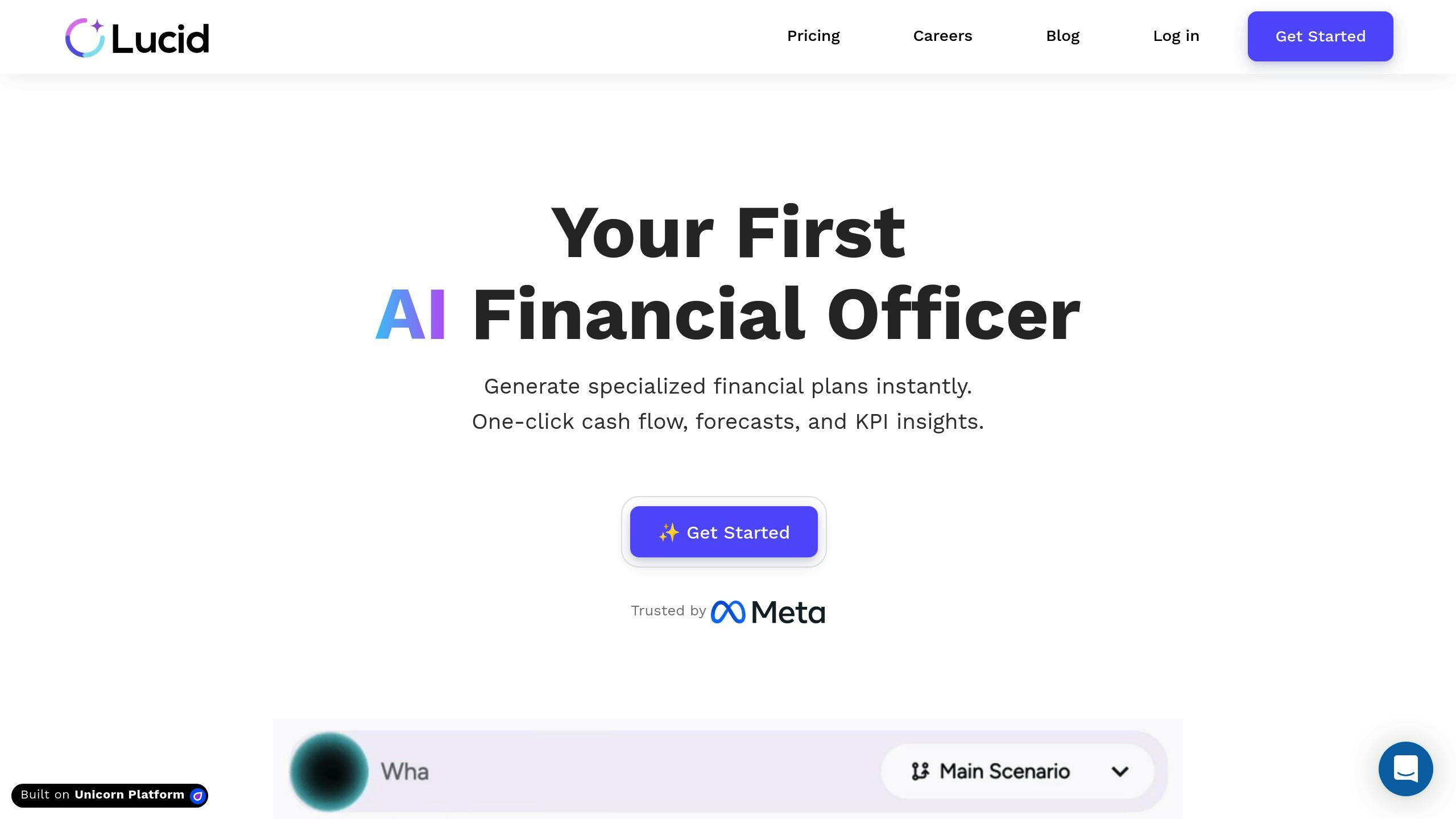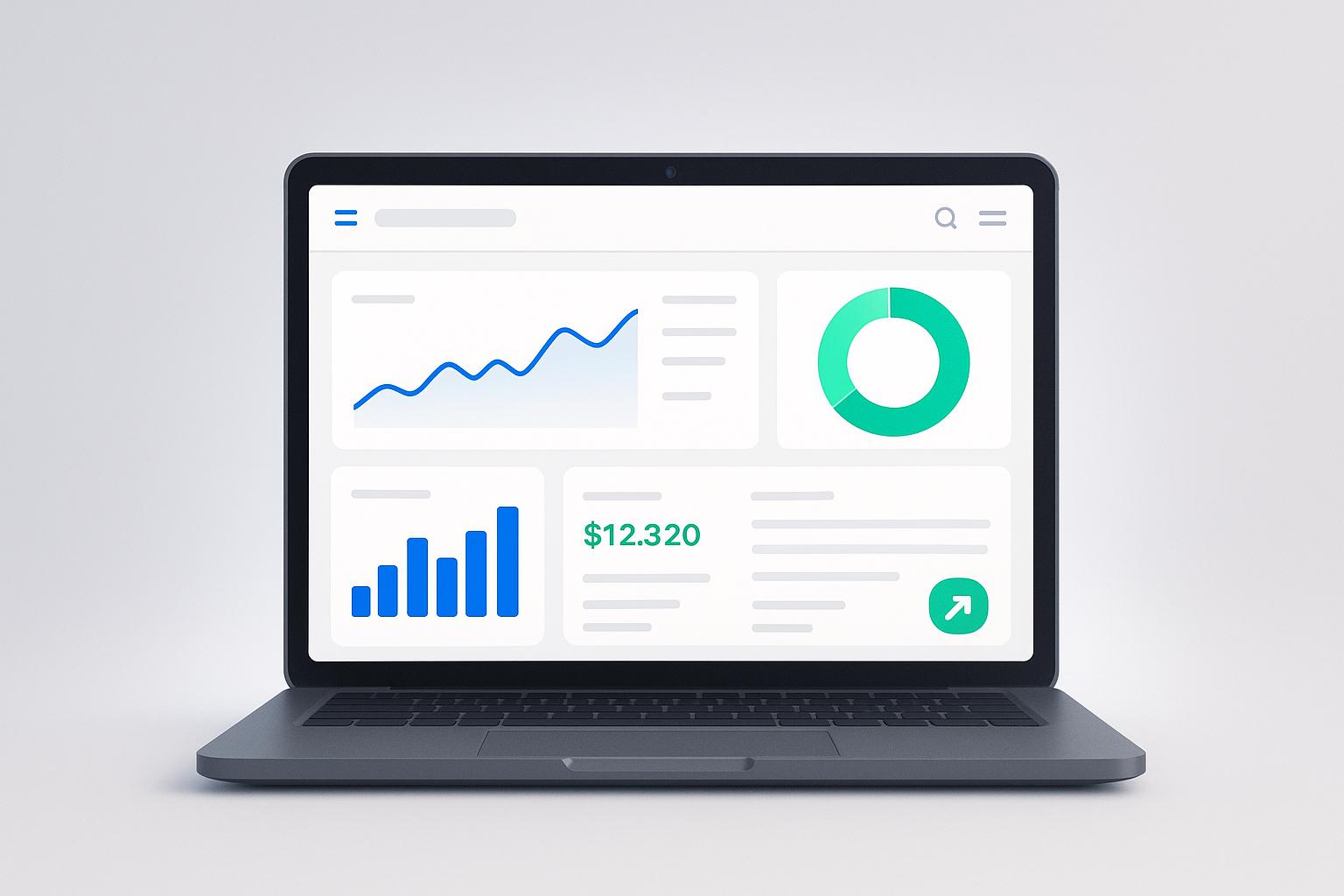Real-time AI is transforming financial planning by automating data analysis, improving accuracy, and enabling instant decision-making. Businesses can speed up planning cycles by 30% and improve forecast accuracy by up to 40%. Here's how it helps:
- Better Accuracy: Reduces errors with automated data integration.
- Higher Productivity: Boosts team efficiency by 30%.
- Quicker Decisions: Offers instant scenario analysis.
- Risk Awareness: Flags potential financial issues early.
- Automation: Frees up time for strategic tasks.
AI tools like Planful Predict and FP Alpha provide real-time insights, forecast trends, and help businesses manage risks effectively. Integration with platforms like QuickBooks, banking systems, and payroll tools ensures seamless data flow, enabling smarter financial decisions. Whether it's budget planning, risk management, or tailored strategies, AI is reshaping how financial professionals work.
How Real-Time AI Works in Financial Planning
How AI Integrates and Combines Data
Real-time AI systems provide a complete financial overview by connecting various data sources. These systems automate data collection from platforms like QuickBooks, banks, and payroll systems. They then organize and unify this data to maintain consistency across financial records.
| Data Source Type | Information Processed | AI Action |
|---|---|---|
| Accounting Software | Transaction records, invoices | Categorization, reconciliation |
| Banking Systems | Cash flow, account balances | Monitoring, fraud detection |
| Payroll Systems | Employee costs, benefits | Expense tracking, budget allocation |
| Market Data | Industry trends, benchmarks | Comparative analysis, forecasting |
AI Analysis and Decision-Making Processes
Once the data is integrated, machine learning algorithms get to work, analyzing it to provide actionable insights through several steps:
- Pattern Recognition: AI identifies trends and anomalies in the data, helping to spot risks or opportunities early.
- Predictive Analytics: By using historical and current data, these systems forecast cash flow, revenue, risks, and budgets.
- Real-Time Decision Support: AI evaluates different scenarios at once, offering instant recommendations on investments, budgets, and other financial choices.
This process is especially useful for risk management, where AI can flag unusual patterns that might signal fraud or financial irregularities [3]. By turning raw data into strategic insights, AI helps businesses make smarter financial decisions.
Next, we’ll dive into how these AI-driven insights are applied to reshape financial planning.
Uses of Real-Time AI in Financial Planning
Planning and Comparing Financial Scenarios
Real-time AI is changing the way businesses evaluate financial scenarios by offering instant insights and comparisons. Modern AI tools allow financial teams to simulate multiple scenarios at once, helping them anticipate outcomes before making crucial decisions.
| Scenario Type | AI Analysis Capabilities | Business Impact |
|---|---|---|
| Budget Planning | Real-time cash flow projections | Optimize resource allocation |
| Investment Options | Risk-return analysis | Make informed investment decisions |
| Growth Strategies | Market impact predictions | Identify growth opportunities |
| Cost Reduction | Expense pattern analysis | Reduce operational expenses |
Managing Risks and Forecasting Finances
AI tools are invaluable for identifying risks and predicting financial performance by analyzing both real-time and historical data. For instance, Planful Predict is known for its ability to detect anomalies and forecast trends effectively [4].
With these tools, businesses can:
- Spot unusual patterns that may signal financial risks
- Create accurate revenue forecasts based on market trends
- Continuously monitor key performance indicators
- Adjust strategies in response to market shifts
These capabilities enable businesses to shift from reactive to proactive financial planning, driven by real-time data.
Creating Tailored Financial Plans
AI platforms can craft financial strategies that align with specific business goals. Tools like FP Alpha analyze unique operational data to deliver tailored recommendations [2].
Key features of these platforms include:
- Personalized Analysis: By integrating with systems like QuickBooks or payroll platforms, AI generates financial plans that reflect a company’s unique operations and objectives.
- Dynamic Adjustments: Recommendations evolve in real-time, adapting to performance metrics and market changes.
- Industry-Specific Insights: AI benchmarks a business’s performance against industry standards to uncover areas for improvement and potential advantages.
Choosing the right AI platform is essential to fully leverage these benefits, which we’ll discuss in the next section.
Platforms for Real-Time AI Financial Planning
Lucid Financials: A Top AI Financial Tool

Lucid Financials is designed to simplify financial planning for startups, SMBs, and larger enterprises. It connects directly with tools like QuickBooks, payroll systems, and banking platforms, offering real-time financial management. Features like instant planning, scenario modeling, and industry benchmarks make it a go-to solution for businesses aiming to streamline their financial processes.
This platform highlights the level of integration and functionality that businesses should prioritize when choosing an AI financial planning tool.
Key Features to Consider in AI Financial Tools
When choosing an AI-driven financial platform, focus on these essential features:
- Real-time forecasting: Combines data analysis and predictive tools for quick, actionable insights.
- Strong security: Protects sensitive financial data with verified sources and advanced safeguards.
- Seamless integration: Syncs with accounting, payroll, and banking systems for unified management.
These features are crucial for evaluating and comparing the many tools available in the market.
Comparing AI Financial Tools for Businesses
Here’s a quick breakdown of some top AI financial tools and their standout features:
| Platform | Primary Focus | Key Strengths |
|---|---|---|
| Lucid Financials | Comprehensive Planning | Scenario modeling, industry benchmarks |
| Datarails FP&A Genius | Visual Analytics | Real-time dashboards |
| Planful Predict | Forecasting | Predictive analytics |
| Macroaxis | Investment Analysis | Wealth optimization |
When deciding on a platform, consider your business's unique needs, budget, and growth goals. While enterprise-level tools offer broad scalability, specialized solutions might better address niche requirements.
sbb-itb-17e8ec9
The Future of Real-Time AI in Financial Planning
Trends in AI for Financial Planning
Generative AI and predictive modeling are transforming financial planning by simplifying complex analyses and delivering insights instantly. Combining real-time data processing with predictive analytics helps businesses make quicker, well-informed decisions without sacrificing accuracy or compliance.
These technological shifts are reshaping how financial planning is done, enabling professionals to provide more strategic, data-backed results. As AI tools improve, they boost the speed and accuracy of financial analysis, helping businesses adapt more effectively to changing market conditions.
How AI Supports Financial Professionals
AI improves decision-making for financial professionals by offering instant insights and automating repetitive tasks, giving them more time to focus on strategic planning. These platforms provide tools for quick analysis, better risk management, and tailored financial solutions.
Key AI-driven features include:
| Function | Role in Financial Planning |
|---|---|
| Real-time Analysis | Processes market trends and financial data instantly |
| Risk Assessment | Detects potential financial risks early |
| Streamlined Operations | Automates reporting and creates personalized plans |
Using these tools, financial professionals can craft more dynamic and adaptive financial strategies. For instance, platforms like Macroaxis help uncover investment opportunities and design personalized financial plans based on up-to-the-minute market data [1].
The increasing integration of AI with human expertise is paving the way for a new era in financial planning. This partnership allows professionals to concentrate on strategic decisions and building client relationships, while AI handles data-heavy tasks and routine analyses.
How Can Finance Teams Leverage AI for Better Decision-Making
Conclusion
Real-time AI is reshaping financial planning, empowering businesses to make quick, data-driven decisions with exceptional precision. This evolution boosts efficiency, helping organizations adapt swiftly to market shifts and seize new opportunities.
AI tools bring advanced financial planning features by offering real-time insights, smooth integration, and predictive modeling. These capabilities help businesses in several key areas:
| Capability | Business Impact |
|---|---|
| Strategic Analysis | Better decision-making through actionable insights |
| Process Automation | Simplified workflows and increased operational speed |
| Forward Planning | Improved forecasting and scenario planning |
| Risk Management | Early detection and handling of potential financial risks |
AI is more than just a tech upgrade - it’s a game-changer for financial management. Integrating AI into financial planning processes allows businesses to achieve both operational efficiency and strategic insight, helping them tackle uncertainty with greater confidence.
Looking forward, advancements in AI-driven financial tools will unlock even more opportunities for businesses. Success will depend on choosing the right tools that meet specific needs and using them effectively to sharpen financial decision-making. This shift highlights the growing importance of AI tools in staying competitive in today’s data-focused business environment.
FAQs
How can AI be used in financial planning?
AI is changing the way financial planning is done by processing real-time data from various sources, offering precise insights, and automating repetitive tasks.
Here are some ways AI improves financial planning:
| Function | AI Capability | Business Impact |
|---|---|---|
| Data Analysis | Processes real-time financial data | Boosts accuracy and minimizes forecasting errors |
| Risk Management | Monitors risks and provides early warnings | Helps identify and address risks proactively |
| Scenario Planning | Automates data collection and simulations | Streamlines workflows and supports better decisions |
AI-powered tools can spot transaction errors, recognize trends, and develop tailored financial plans to meet specific business goals. By analyzing historical data, these platforms predict outcomes and suggest ways to allocate resources more effectively.
One of the biggest advantages? AI takes over repetitive tasks, giving financial professionals more time to focus on strategic decisions. To get the most out of AI financial tools, businesses should look for features like:
- Integration with real-time data
- Predictive analytics capabilities
- Compatibility with existing financial systems
With these tools, businesses are rethinking financial planning, making AI a key part of modern strategies.


